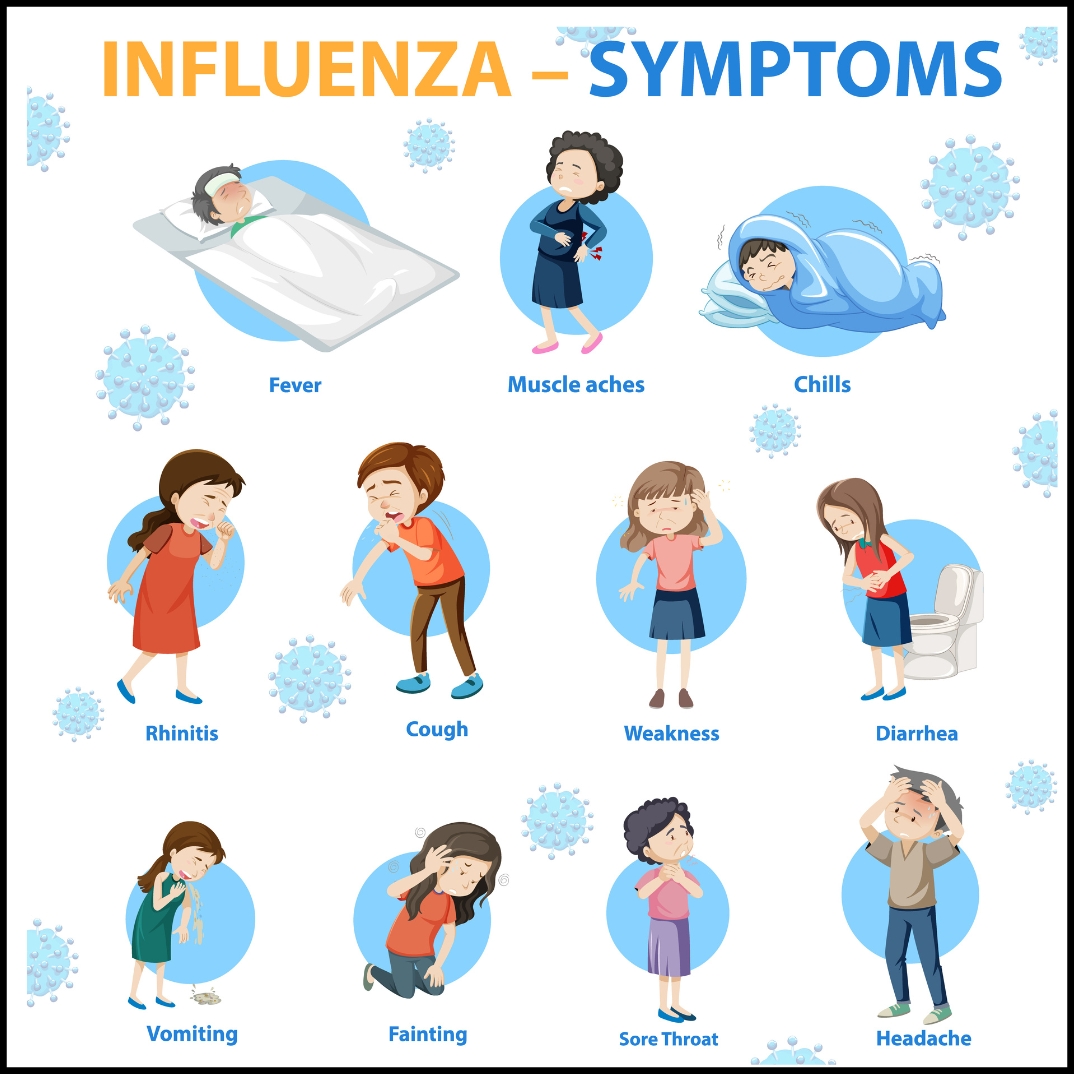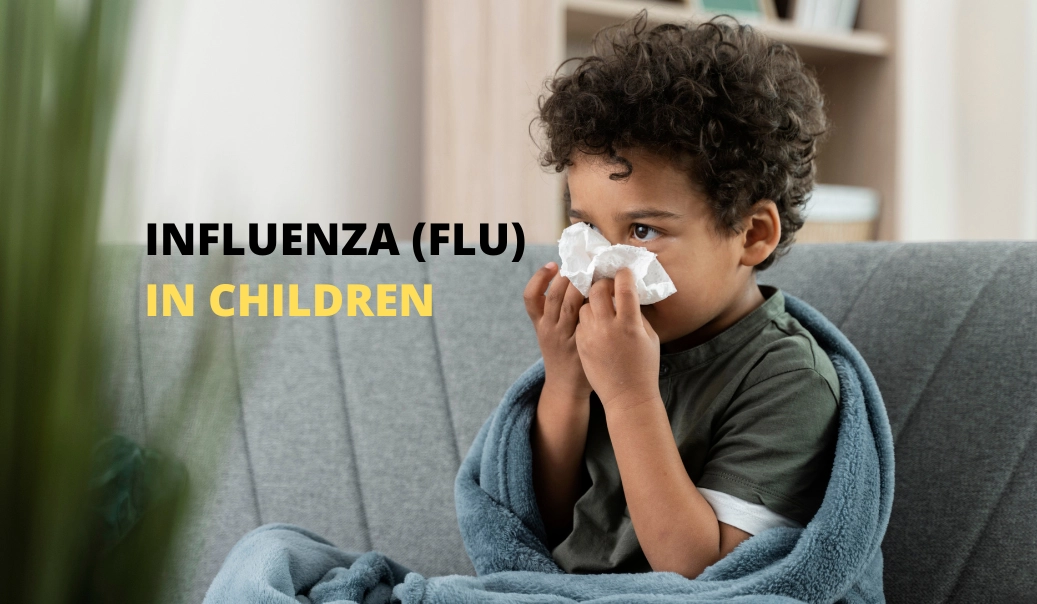The flu or influenza is a seasonal condition, resulting in infection of the respiratory system including the nose, throat, and lungs. In children, the flu often presents with symptoms such as high fever, chills, cough, sore throat, runny or stuffy nose, muscle aches, and fatigue. What makes the flu particularly concerning in children is their vulnerability to more severe complications, such as pneumonia, ear infections, and exacerbation of pre-existing medical conditions like asthma. Young children, especially those under the age of five, are at a higher risk of flu-related hospitalizations and, in rare cases, even death. Due to the risk of severe illness and transmission to others, it is important to take preventive measures like annual flu vaccinations and good hygiene practices to protect children from this viral infection.
To manage influenza in children, it is essential to ensure they get plenty of rest, stay well-hydrated, and receive appropriate over-the-counter medications as recommended by a doctor to alleviate symptoms like fever and congestion. Isolation from other children and adults during the contagious period can also help prevent the spread of the virus. Parents should closely monitor their child's condition and seek medical attention if symptoms worsen or if the child experiences difficulty breathing persistent high fever, or signs of dehydration. The flu can be particularly challenging for children, so timely and appropriate care is crucial for their well-being.
Causes of Influenza in Children
The flu is a very common condition among children, primarily because of their immunity levels. The infection passes on from one child to another through sneezing or coughing, coming into close contact at school or in the playground. There is also a possible cause of infection when children handle contaminated surfaces such as toys, books, shared utensils, stationary amongst others.
The highest of developing flu infection for a child comes from close proximity of those who may be affected & contagious, lack of personal hygiene, and not having had the flu vaccine.
Younger children, with underlying health conditions remain at a higher level of risk of acquiring the flu infection on account of their immune-compromised state.
Symptoms of Influenza in Children
Children suffering from the season flu will exhibit the following symptoms within 24 hours of being infected,
- High Fever
- Body Pains
- Sore Throat
- Severe Cough
- Blocked Nose
- Excessive Fatigue
In addition to the above common symptoms, in some cases the child may also have diarrhea, nausea, and vomiting as additional symptoms.

If you suspect that your child may have influenza, it is essential to seek medical attention promptly. Consult with General Physician or Pediatrician to ensure your child's health.
How to Prevent Influenza in Children?
Vaccination: The most effective way to prevent influenza is through annual flu vaccination. Children older than 6 months should receive a flu vaccine every year. The vaccine is particularly important for children with underlying health conditions, as they are more susceptible to complications.
Hand Hygiene: Teach children the importance of washing their hands frequently with soap and water for at least 20 seconds, especially after coughing or sneezing, using the restroom, and before eating.
Respiratory Hygiene: Teach children to cover their mouth and nose with a tissue or their elbow when they cough or sneeze to prevent the spread of the virus.
Avoid Close Contact: Encourage children to avoid close contact with individuals who are sick. If your child is sick, keep them home to prevent the spread of the virus to others.
Good Nutrition: Ensure your child maintains a healthy diet and gets adequate rest to boost their immune system.
Cleaning and Disinfecting: Regularly clean and disinfect frequently touched surfaces in your home to prevent the virus from spreading.
Treatment for Influenza
Rest: Children with the flu need plenty of rest to help their bodies recover. Encourage them to take it easy and get enough sleep.
Hydration: Ensure that your child drinks plenty of fluids, such as water, clear soups, and oral rehydration solutions, to stay hydrated. This helps to relieve symptoms and prevent dehydration.
Medical Evaluation: If your child's symptoms are severe or if they have underlying health conditions, consult a healthcare provider for a proper diagnosis and treatment plan.
Difference Between Flu & Cold
In many instances parents tend to misunderstand or misdiagnose the symptoms of common cold and flu. Given that there are some commonalities, it is quite possible to identify one for the other. Some of the variances between common cold & flu are given below for better understanding and identification of the two:
Fever: Common cold is generally not accompanied by fever, and even if it does, it is low fever. Flu, on the other hand will evidence high fever.
Headache: Headache is uncommon with common cold, very common with flu.
Sneezing: Sneezing is very common with cold, less so with flu.
Cough: Cough is less common with cold, but definitely present with flu.
Body ache & tiredness: Mild in case of cold, severe in case of flu.
In conclusion, influenza, or the flu, is a seasonal viral infection that can significantly impact children's health. Its symptoms, including high fever, cough, sore throat, and fatigue, can be particularly challenging for young individuals, often leading to more severe complications like pneumonia or exacerbation of underlying conditions. Preventive measures such as annual flu vaccinations, good hygiene practices, and timely medical attention are essential for safeguarding children against the flu. Recognizing the differences between the flu and common cold is crucial for accurate diagnosis and appropriate care. By taking proactive steps to prevent and manage the flu in children, we can help ensure their well-being and reduce the risk of serious illness and transmission to others.
If you suspect that your child may have influenza, it is essential to seek medical attention promptly. Consult with General Physician or Pediatrician to ensure your child's health.
Related Blog Articles:
1. Staying Healthy in the Rainy Season
2. Flu Season and Kids: Protecting Your Children from Influenza
3. Importance of Flu Vaccines: Myth vs. Fact
.webp)














